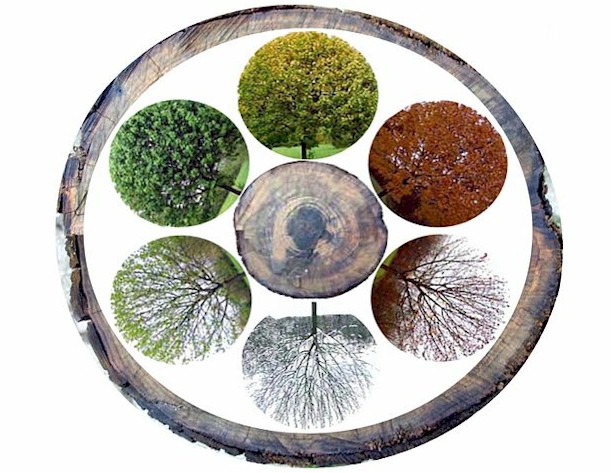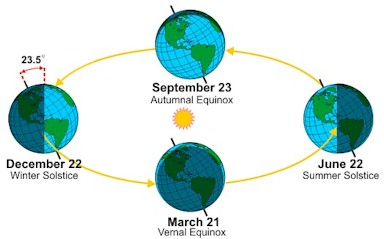Contents
I live in the suburbs of Paris, France and it’s Thursday 18th September 2014, just four days from autumn and we’ve got a cloudless sky with one of the most beautiful days we’ve had all year!

The six ecological seasons pictured in the annual rings of a tree (click for source)
It is getting a little colder in the morning and the sun is setting noticeably earlier as the days shorten, announcing autumn. The season is changing, and I ran across the above image of a tree going through its seasonal changes. I was out in my garden noticing that my neighbor had picked most of his homegrown vegetables (of which he offered me some yummy string beans) and taking in the growing amount of falling leaves that will shortly end up as compost.
We look forward to seasons, something is in the air at all seasonal changes. Of course it’s part of the water, land, flora, fauna cycles… but it’s also part of man’s cycle.
One full year, everywhere on earth, swings man through the awakening, going outdoors of spring, the lazy balminess of summer, the back to school/work and

Four season astronomical calendar (click for source)
Cooling of autumn to end with the cold but invigorating winter. Depending on his latitude, man is affected more or less by seasons with those in the temperate zones experiencing definite seasonal changes.
Without going into details, seasons are the result of the tilt of Earth’s axis.
Seasons represent one of the ‘recurring phenomena’ on Earth, like day and night when man NEEDS eight hours of sleep in total dark and quiet for ‘best rest’ of his body and mind.
Similarly, nature and that pictured tree as well as other flora and fauna need the four distinct seasons to: bud, grow, be pollinated, develop and produce seed and flowers, shed their harvest, rest and ready themselves for the next cycle of seasons.
Often nature documentaries will follow various plants, animals and locations… through their seasonal adaptations. Seasons tell time and are accompanied by a life story. With annual plants, their entire history from seeding to wilting lasts about 7 months.
Did you notice that the calendar which most of us are aware of, with planet movements, counts four seasons but ecologists count six seasons.
Six ecologist seasons
- Prevernal 1 March–1 May pre-spring thaw
- Vernal 1 May–15 June spring growing season
- Estival 15 June–15 August high summer
- Serotinal 15 August–15 September late summer
- Autumnal 15 September–1 November fall harvesting season
- Hibernal 1 November–1 March winter
In the above ecological calendar, the longest and ‘deadest’ season is Hibernal, it lasts four months. All the other five growing seasons are compacted into the eight remaining months.
Three thoughts come to mind:
-
- Man is on the outlook for exoplanets, planets that revolve around the sun at about the same distance that earth is from its sun. They feel there could be life there…Do these planets have astronomical ‘time creating’ phenomena like a tilt for the seasons accompanied by a one year plant life cycle with an eight month growing cycle? What about the correct revolution period for day and night? Just being a certain distance from a sun is not enough for life.
-
- Here’s a question to ponder that I’ll answer later on in The Explanation in another related context. The 5 ecological growing seasons are concentrated in an eight-month period while the longest and last, cold hibernal winter, or put another way, winter, immediately previous to the pre-spring thaw lasts for four full months. It seems out of proportion. Is there a reason?
- Are there any other series of ‘seasons’ in the year that are counted based on the movement of astral bodies? The short answer is yes, you can always do a little study to find out what they are. Let’s say I’ll leave you with that homework for now.
On Earth, seasons are intimately related to the life cycle. They are much more than timepieces. Seasons tell a story about life. There are all sorts of stories that revolve around the seasons, but ts there a key story, if so, what is it?
The Explanation will get more and more interesting as we go deeper and deeper into life related subjects. Sign up in the right column to receive notifications of new posts and not miss out. I’m interested in your comments below.
Dig Deeper into The Explanation
Join The Explanation Newsletter to stay informed of updates. and future events. No obligations, total privacy, unsubscribe anytime, if you want.
Online Study Courses to Unlock Bible meaning via Biblical Hebrew… with no fuss. Free video courses that put you in the driver’s seat to navigate the Bible as never before. Join now
The Explanation series of seven books. Free to read online or purchase these valuable commentaries on Genesis 1-3 from your favorite book outlet. E-book and paperback formats are available. Use this link to see the details of each book and buy from your favorite store.
Since you read all the way to here… you liked it. Please use the Social Network links just below to share this information from The Explanation, About seasons: it’s a gorgeous September day in Paris


